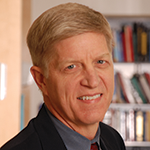“Here at UNC, our osteoarthritis research starts at the very basic level, from cells and mouse models to clinical research and then out into the community,” says Richard F. Loeser Jr., MD, Herman and Louise Smith Distinguished Professor, Division of Rheumatology, Allergy and Immunology, director of basic and translational research. He notes that division team meetings are also highly collaborative, gathering basic science and clinical researchers to solicit input on proposed projects. The objective is to make projects strong and relevant to promoting better care for patients, he says. “It’s a great way to work together.”
As an example of that focus on translational research, Dr. Loeser’s laboratory has recently begun to apply basic science techniques to studying samples obtained from JoCoOA study participants. He and collaborators at the Research Triangle Institute will be using metabolomics to explore novel biomarkers for osteoarthritis progression.
Philanthropy, Training & Camaraderie

The center’s inception traces to the philanthropy of North Carolinian D. Jones (Doc) Thurston Jr. (1908–1993), a graduate of UNC who established a trucking business, Thurston Motor Lines Inc., and was a patient of John Winfield, MD, former chief of the division and founding director of the Thurston Arthritis Research Center. An ongoing Board of Directors comprising community lay and professional members continues philanthropic fundraising to support the Center. Other major funding comes from the Arthritis Foundation, the CDC and the NIH.
One of the strengths of the program, notes Saira Z. Sheikh, MD, assistant professor of medicine in the division, is that the division combines rheumatology and allergy/immunology. This was one of the attractions for her as a post-doc fellow, because she wanted to follow her interests in both fields. She is dual-trained and double-boarded in both areas and was invited to join the faculty after completing her fellowship. Currently, she co-directs the UNC Rheumatology Lupus Clinic.

Dr. Sheikh lauds the division’s robust clinical trials program offering novel therapeutic options to patients with all types of rheumatic disease. For her, the approachability and camaraderie in the division facilitated her growth as a clinician and researcher. “Having the opportunity to train at a place like this, you learn not only the science but also the art of practicing different clinical approaches,” she says.
Indeed, approachability and collaboration foster ongoing excellence in the division’s many domains, said those we interviewed. Dr. Callahan sums up the atmosphere in this way: “I work with fantastic individuals, and I truly love where I work—that’s a wonderful thing to be able to say.”

